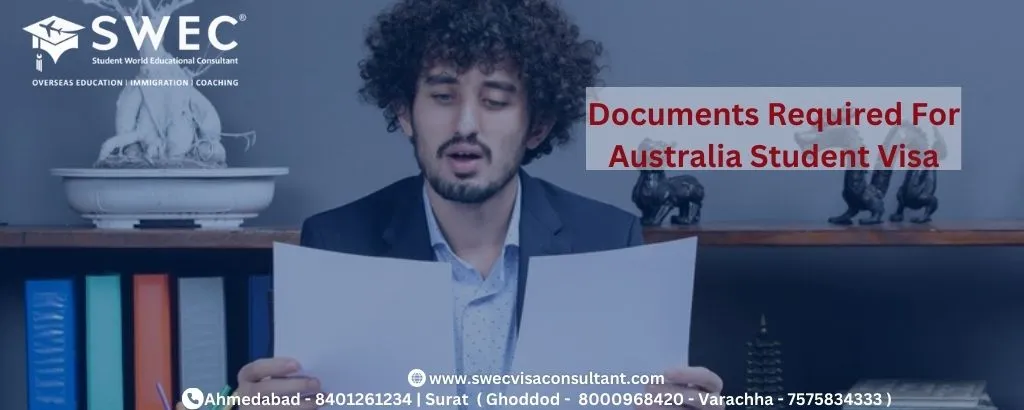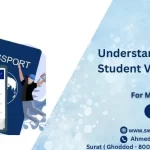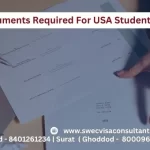Table of Contents
The Australian Student Visa (subclass 500) is designed for international students who wish to study full-time in Australia. This visa allows students to enter Australia, study at an approved educational institution, and live there for the duration of their course. The student visa is crucial for individuals who aim to pursue higher education or vocational training in Australia, benefiting from the country’s world-class education system.
What is the Australian Student Visa (Subclass 500)?
The Australian Student Visa (subclass 500) is a temporary visa that enables international students to live and study in Australia. It covers all types of full-time courses, including primary, secondary, and higher education courses, as well as vocational education and training (VET) programs. The visa ensures that students meet specific health and character requirements and adhere to their visa conditions.
Purpose: Why it is Essential for International Students Who Wish to Study in Australia
For international students, the Australian Student Visa is essential because it legally authorizes their stay in Australia for educational purposes. It provides access to a range of opportunities, including studying at prestigious institutions, experiencing Australian culture, and gaining valuable international experience. This visa is a gateway to academic and professional growth in a globally recognized education system.
Benefits: Key Advantages of Obtaining an Australian Student Visa
- Access to Quality Education: Students gain entry to some of the world’s best universities and educational institutions in Australia.
- Work Rights: The visa allows students to work part-time during their studies and full-time during breaks, helping them manage living expenses.
- Pathway to Further Opportunities: Completing studies in Australia can lead to opportunities for further education or employment, and may provide pathways to permanent residency.
- Cultural and Personal Growth: Students experience Australian culture and lifestyle, enriching their personal and professional lives.
The objective of the Blog
Purpose: This blog aims to provide detailed information about the essential documents required for an Australian student visa application. Understanding these documents is crucial for a smooth application process and successful visa approval.
Outcome: By the end of this blog, readers will have a comprehensive understanding of the documents needed, why they are required, and how to prepare them effectively. This guidance will help ensure a successful visa application and a hassle-free transition to studying in Australia.
Eligibility Criteria for the Australian Student Visa (subclass 500)
Basic Criteria: Who Can Apply for the Australian Student Visa
To apply for the Australian Student Visa (subclass 500), you must meet several basic eligibility requirements:
- Age: You must be at least 6 years old. If you are under 18, additional requirements apply, such as accommodation and welfare arrangements.
- Course Enrollment: You must be enrolled in a registered course at an approved educational institution in Australia.
- Genuine Temporary Entrant (GTE) Requirement: You must demonstrate that you intend to stay in Australia temporarily to study and not for any other reasons, such as migration.
- Financial Capacity: You need to show that you have sufficient funds to cover your tuition fees, living expenses, and travel costs.
- English Language Proficiency: Depending on your country of origin and educational background, you may need to provide evidence of your English language proficiency.
Educational Requirements: Necessary Academic Qualifications and Accepted Educational Institutions
- Academic Qualifications: You must have the necessary academic qualifications for your chosen course. This generally includes proof of prior studies and certifications. Each educational institution may have specific entry requirements depending on the level and field of study.
- Approved Educational Institutions: You must be enrolled in a course provided by a registered Australian educational institution that is on the Commonwealth Register of Institutions and Courses for Overseas Students (CRICOS). This ensures that the institution meets Australian government standards.
Health and Character Requirements: Health Checks and Police Clearances, if Applicable
- Health Checks: You may need to undergo a health examination to ensure you meet the health requirements. The exact requirements depend on your country of origin and the length of your stay in Australia.
- Character Requirements: You must provide a police clearance certificate from your home country to demonstrate that you are of good character. This is to ensure that you do not pose any security risks.
Australian Student Visa Application Process
Initial Steps: Researching and Applying to Australian Educational Institutions
- Research Institutions: Start by researching and choosing an Australian educational institution that offers the course you wish to study. Ensure that the institution is registered with CRICOS.
- Application to Institutions: Apply to your chosen institution and secure an offer letter or confirmation of enrollment (CoE). This document confirms your acceptance into a registered course.
Submission Process: Overview of How to Submit the Visa Application and Required Documents
- Complete Visa Application Form: Fill out the Australian Student Visa application form (Form 157A) accurately. This form can be completed online through the ImmiAccount portal or submitted in person.
- Gather Required Documents: Collect all the necessary documents as outlined in the next section of this blog. This includes your CoE, passport, proof of financial capacity, English proficiency test results, GTE statement, and health insurance proof.
- Submit Application: Submit your completed visa application form along with the supporting documents either online or at an Australian visa application centre (AVAC). Pay the application fee as required.
- Visa Processing: After submission, the Department of Home Affairs will process your application. This may involve additional requests for information or documentation.
Essential Documents you need for Australian Student Visa
1. Valid Passport
Validity Requirements: Passport Must Be Valid for the Entire Duration of Stay Plus Additional Time
- Duration of Validity: Your passport must be valid for the entire duration of your intended stay in Australia. It is advisable to have at least six months of validity beyond your planned departure date from Australia.
- Additional Time: Ensure your passport is valid for an extended period beyond your stay to accommodate any unforeseen delays or additional travel plans.
Details Required: Information Needed from Your Passport (Personal Details Page)
- Personal Details Page: You need to provide a clear copy of the personal details page of your passport. This page includes your full name, date of birth, nationality, passport number, and photograph.
- Document Requirements: Ensure that the copy is clear, legible, and up-to-date. Any discrepancies or expired passports can delay your visa application process.
How to Obtain: If You Don’t Have a Passport, How to Get One Quickly
- Application Process: If you do not have a passport, you need to apply for one at the nearest passport office or consulate. Gather necessary documents such as proof of identity, address, and photographs as required by the passport authorities.
- Expedited Services: Opt for expedited or urgent processing services if you need the passport quickly. Check the processing times and fees associated with fast-tracking your application.
2. Confirmation of Enrollment (CoE)
Definition: What is a CoE and Its Role in the Visa Application
- Definition: The Confirmation of Enrollment (CoE) is an official document issued by your Australian educational institution. It confirms that you have been accepted into a course and are eligible to apply for a student visa.
- Role in Visa Application: The CoE is a mandatory document required to complete your visa application. It verifies your enrollment status and provides details about your course and institution.
Obtaining a CoE: Steps to Receive a CoE from Your Educational Institution
- Application Process: Once you have been accepted into an educational institution, you will receive a CoE after fulfilling any required conditions, such as paying the tuition deposit.
- Requesting CoE: Ensure that you request the CoE from your institution as soon as you receive your acceptance letter. The institution will issue the CoE electronically or by mail.
Content of CoE: Information Typically Included, Such as Course Details and Start/End Dates
- Course Details: The CoE includes essential information about your course, including the course name, start and end dates, and duration.
- Institution Information: It also contains details about the institution, such as its name, CRICOS code, and unique student ID.
3. Visa Application Form (Form 157A)
Explanation: Detailed Overview of Form 157A
- Form 157A: Form 157A is the standard application form for an Australian Student Visa. It collects personal information, details of your intended course, and other relevant data required for visa assessment.
- Purpose: This form is used to process your visa application and ensure all necessary details are provided.
How to Fill Out: Step-by-Step Instructions for Completing the Form Correctly
- Personal Information: Enter your full name, date of birth, and nationality as per your passport. Provide accurate contact details and address.
- Course and Institution Details: Fill in the details of your course and educational institution as mentioned in your CoE.
- Health and Character Information: Answer questions related to your health and character, including any prior criminal convictions or medical conditions.
Submission: How to Submit the Form Online or Physically
- Online Submission: You can submit Form 157A online via the ImmiAccount portal. Ensure that all fields are completed and the form is signed electronically.
- Physical Submission: If submitting physically, send the completed form along with the required documents to the nearest Australian Visa Application Centre (AVAC) or Australian High Commission.
4. Proof of Financial Capacity
Purpose: Why Demonstrating Financial Capacity Is Crucial
- Financial Proof: Demonstrating financial capacity is essential to show that you can cover your tuition fees, living expenses, and other costs while studying in Australia.
- Visa Requirement: The Australian government requires proof to ensure that you will not be financially dependent on public funds during your stay.
Types of Evidence: Bank Statements, Financial Guarantees, Scholarship Letters
- Bank Statements: Provide recent bank statements showing sufficient funds. This could include personal savings or funds from family.
- Financial Guarantees: A letter from a financial guarantor or sponsor who will support your studies.
- Scholarship Letters: If you have received a scholarship, provide a letter confirming the amount and duration of the scholarship.
Minimum Amount: Current Financial Requirements Set by the Australian Government
- Tuition Fees: Ensure you have funds to cover your tuition fees for the first year.
- Living Costs: You need to show proof of having enough funds to cover your living expenses. As of 2024, the Australian government requires evidence of AUD 21,041 per year for living costs.
Acceptable Documents: Specific Documents Accepted as Proof of Financial Capacity
- Accepted Documents: Include bank statements, fixed deposit certificates, and official financial guarantees. Ensure that these documents are recent and accurate.
5. Proof of English Proficiency
Accepted Tests: IELTS, TOEFL, PTE, or Other Approved English Tests
- English Tests: Accepted tests include IELTS (International English Language Testing System), TOEFL (Test of English as a Foreign Language), and PTE (Pearson Test of English). Ensure that the test you choose is approved by your educational institution.
Score Requirements: Minimum Scores Needed for Different Courses or Institutions
- Minimum Scores: Different courses and institutions have varying score requirements. Typically, a score of 6.0 to 6.5 in IELTS or equivalent is required for undergraduate courses, and 6.5 to 7.0 for postgraduate courses.
Submission: How to Submit English Proficiency Test Results
- Submitting Scores: Test results should be submitted directly from the testing authority to your educational institution. You may also need to provide a copy of your visa application.
6. Genuine Temporary Entrant (GTE) Statement
Purpose: Why the GTE Requirement Is Necessary
- GTE Requirement: The Genuine Temporary Entrant (GTE) requirement is designed to ensure that you are entering Australia temporarily to study and not for other reasons like migration.
How to Write: Tips for Writing a Compelling GTE Statement
- Personal Statement: Write a personal statement explaining your intentions, study plans, and why you chose Australia for your education.
- Include Background: Describe your educational and career background, how your chosen course aligns with your goals, and your plans after completing your studies.
What to Include: Key Points to Address, Including Your Intentions and Background
- Intentions: Clearly state your intentions to study in Australia and return to your home country after completing your studies.
- Background: Include details about your academic history, employment experience, and how studying in Australia fits into your plans.
7. Health Insurance
Mandatory Health Insurance: Overseas Student Health Cover (OSHC) Requirements
- OSHC Requirement: Overseas Student Health Cover (OSHC) is mandatory for all international students in Australia. It provides health insurance coverage for the duration of your stay.
How to Obtain OSHC: Steps to Purchase and Provide Proof of OSHC
- Purchase OSHC: You can purchase OSHC through various providers before applying for your student visa. Many educational institutions offer OSHC packages.
- Proof of Coverage: Provide proof of OSHC coverage when submitting your visa application. This can be in the form of an insurance certificate or policy document.
Proof of Coverage: How to Demonstrate You Have OSHC
- Providing Proof: Include a copy of your OSHC policy with your visa application. Ensure it covers the entire duration of your stay in Australia.
Additional Documents Based on Specific Circumstances
When applying for an Australian Student Visa, certain additional documents may be required based on your specific circumstances. This section covers these additional requirements to ensure a smooth and complete visa application process.
For Underage Students
Additional Requirements:
If you are under 18, additional documentation is needed to ensure that appropriate care and supervision are arranged while studying in Australia.
- Parental Consent Forms: You must provide a signed consent form from your parents or legal guardians, granting permission for you to study in Australia. This document confirms that your guardians are aware of your educational plans and are supportive of your move.
- Guardian Arrangements: If you are under 18, you may need to appoint a suitable guardian in Australia. This guardian must be approved by the Australian government and should be responsible for your welfare during your stay.
Guardianship:
- Information on Appointing a Guardian: You need to provide details about the person appointed as your guardian, including their contact information and relationship to you. The guardian must be over 21 years old and undergo a background check to ensure they can provide appropriate care.
For Dependents
Documents Required:
If you plan to bring family members with you, you will need to provide additional documentation for each dependent.
- Passports: Clear copies of the passports of all dependents.
- Birth Certificates: Proof of relationship, such as birth certificates for children.
- Other Supporting Documents: This may include marriage certificates or evidence of financial support for your dependents.
Visa Process for Dependents:
- Including Dependents in Your Visa Application: You must submit a separate visa application for each dependent. Ensure you include all required documents and provide evidence of your ability to support them financially during your stay.
For Students with a Previous Visa History
If you have previously held a visa, especially an Australian visa, you need to provide documentation related to your past visa history.
- Previous Visa Details: Include copies of your previous visa grants and refusals. Explain any issues faced during your previous visa periods, such as overstays or breaches of visa conditions.
- Additional Information: Address any past visa issues in your current application. Be transparent about previous visa refusals or cancellations and provide explanations if necessary.
For Scholarship Holders
If you have received a scholarship, include detailed documentation about the scholarship in your visa application.
- Proof of Scholarship Award: Provide an official letter or certificate confirming the scholarship award. This should include the scholarship’s terms, conditions, and amount.
- How to Include: Incorporate the scholarship details into your visa application by including a copy of the scholarship letter with your financial evidence. Highlight how the scholarship supports your studies and living expenses.
Document Preparation Tips
Preparing your documents meticulously is a critical step in the Australian Student Visa application process. Properly prepared and organized documents can significantly impact the success of your application. Here’s an in-depth guide to ensure your documents meet all requirements and are presented in the best possible manner.
Document Authenticity
The authenticity of your documents is vital for your Australian Student Visa application. The Australian Department of Home Affairs requires all documents to be genuine, accurate, and verifiable. Submitting fraudulent or misleading documents can lead to visa rejection or future difficulties in obtaining visas.
- Verification:
- Educational Certificates: Obtain attested copies of your academic certificates and transcripts from your educational institution. Many institutions provide a formal attestation service.
- Employment Documents: If you’re including employment-related documents, ensure they are on official letterhead and signed by an authorized person.
- Financial Documents: Verify bank statements and financial documents with your bank to confirm that they are accurate and up-to-date. Some banks offer a certification service for documents.
Steps for Verification:
- Contact Issuing Authorities: Reach out to the issuing institutions or authorities to get their certification or attestation.
- Use Verified Services: Utilize services that are recognized by the Australian immigration authorities to verify your documents.
Translations and Notarizations
If your documents are not in English, they must be translated into English. This applies to documents such as personal identification papers, academic records, and legal documents. Accurate translation is essential to ensure that your documents are correctly understood by the visa authorities.
- Certified Translation:
- Translation Services: Engage a certified translation service to convert your documents into English. Ensure that the translation is done by a qualified translator who is recognized by the Australian government.
- Certification Statement: The translated documents should include a certification statement by the translator affirming the accuracy and completeness of the translation.
- Notarization:
- Purpose: Notarization serves to validate the authenticity of the document copies. This may be required for legal documents, affidavits, or any other documents that need to be verified.
- How to Notarize: Visit a notary public or a legal office to get your documents notarized. The notary will provide a stamp or seal to authenticate the document.
Steps for Translation and Notarization:
- Select a Certified Translator: Find a translator accredited by recognized bodies or agencies.
- Complete Notarization: If required, get the documents notarized before submission.
Document Organization
Organizing your documents methodically not only helps in a smooth application process but also demonstrates your attention to detail, which can positively influence the visa decision.
- Checklist:
- Create a Detailed List: Develop a comprehensive checklist of all required documents based on the Australian Department of Home Affairs requirements. This includes personal identification, proof of financial capacity, academic records, and more.
- Mark Off Items: As you gather each document, check it off your list to ensure you have collected everything needed.
- Effective Organization:
- Use Dividers: Organize your documents into categories using dividers or folders. This makes it easier for both you and the visa officers to access and review specific documents.
- Label Documents: Clearly label each document with its purpose, such as “Proof of Financial Capacity,” “Confirmation of Enrollment,” or “English Proficiency Test Results.” This will help in quick identification and retrieval.
Steps for Organization:
- Group Documents: Sort documents into logical groups based on their type and purpose.
- Use Folders or Binders: Place documents into separate folders or binders to keep them organized and protected.
- Prepare a Cover Letter: Include a cover letter summarizing the contents of your application and any specific notes about the documents.
Common Mistakes to Avoid
Making mistakes during the document preparation process can lead to delays, requests for additional information, or even rejection of your visa application.
- Submitting Incorrect Documents:
- Ensure that you are submitting the correct and updated versions of all required documents. Avoid including documents that are not requested or relevant.
- Incomplete Forms:
- Double-check all forms to ensure that every section is completed accurately. Missing information can lead to delays or rejections.
How to Avoid:
- Review Requirements Thoroughly: Carefully review the visa application requirements and guidelines provided by the Australian Department of Home Affairs. Make sure you understand all document requirements and submission procedures.
- Proofread Documents: Carefully proofread all documents and forms to correct any errors or omissions. Consider having a second pair of eyes review your application.
- Consult a Visa Expert: If you are unsure about any part of the document preparation process, seek advice from a visa consultant or immigration expert. They can provide valuable guidance and ensure that your application is complete and accurate.
Submission Process
Once you have gathered and prepared all the necessary documents for your Australian Student Visa application, the next step is to submit them correctly. Proper submission ensures that your application is reviewed promptly and helps avoid unnecessary delays. Here’s a detailed guide on how to submit your documents and track their status effectively.
How to Submit Your Documents
Online Submission
The Australian Department of Home Affairs offers an online application system for student visas, which is often the preferred submission method. The online system allows you to upload your documents directly, making the process more efficient and faster.
- Steps to Upload Documents Online:
- Create an ImmiAccount: If you haven’t already, create an ImmiAccount on the Australian Government’s Department of Home Affairs website. This account will be used to manage your visa application.
- Log In to Your Account: Access your ImmiAccount and select the option to lodge a new student visa application.
- Upload Documents: Follow the prompts to upload each required document. Ensure that all files are in the correct format (usually PDF, JPG, or PNG) and adhere to the size limitations specified by the Department of Home Affairs.
- Confirm Submission: After uploading all documents, review them to ensure accuracy. Confirm and submit your application online.
Physical Submission
In some cases, you may be required to submit physical copies of your documents by mail. This is less common but may be necessary if instructed by the Department of Home Affairs or if online submission is not available.
- Steps to Submit Documents by Mail:
- Prepare Physical Copies: Print out and prepare physical copies of all the required documents. Ensure that they are clear, legible, and properly organized.
- Compile a Submission Packet: Place all documents in a secure envelope or package. Include a cover letter summarizing the contents and any specific instructions or reference numbers provided by the Department of Home Affairs.
- Send via Courier or Post: Use a reliable courier service or postal service to send your documents to the designated address provided by the Department of Home Affairs. Opt for a tracked delivery service to confirm receipt.
Checking Document Status
Once your documents are submitted, it’s important to track their status to ensure that your application is progressing smoothly. The Australian Department of Home Affairs provides tools to check the status of your application online.
- Steps to Check Document Status:
- Log In to Your ImmiAccount: Access your ImmiAccount where you initially submitted your application. This account provides updates and status information about your application.
- Review Status Updates: Check for any status updates or notifications regarding your submitted documents. This may include acknowledgements of receipt or requests for additional information.
- Download Correspondence: If there are any requests for additional documents or information, download and review the correspondence carefully.
Responding to Requests for Additional Information
The Department of Home Affairs may request additional documents or information if they need further clarification on your application. Responding promptly and accurately is crucial to avoid delays in the processing of your visa application.
- Steps to Respond:
- Review the Request Carefully: Read the request for additional information thoroughly. Ensure you understand what is required and why it is needed.
- Gather Required Documents: Collect the requested documents or information. Ensure that these are accurate and meet the specified requirements.
- Submit Additional Information: Log in to your ImmiAccount or follow the instructions provided to submit the additional documents or information. Ensure that you include any reference numbers or details requested.
- Follow-up: After submission, monitor your ImmiAccount for updates. If there is no confirmation of receipt, follow up with the Department of Home Affairs to ensure that your additional information has been received and processed.
Tips for a Smooth Submission Process:
- Double-Check Requirements: Ensure you are fully aware of the submission requirements and deadlines to avoid any last-minute issues.
- Keep Copies: Maintain copies of all documents and correspondence related to your application. This will be useful in case you need to provide additional information or if any issues arise.
- Consult a Visa Expert: If you encounter any difficulties or uncertainties during the submission process, consider consulting a visa expert or immigration consultant for assistance.
Additional Resources
Links to Official Guidelines
For the most current and detailed information on Australian Student Visas, visit the official Department of Home Affairs website.
Helpful Tools and Checklists
To assist with your document preparation, we offer downloadable checklists and templates:
- Australian Student Visa Document Checklist: A comprehensive checklist to ensure you have all required documents ready.
- Visa Application Form (Form 157A) Template: A guide to filling out the visa application form accurately.
Conclusion
In this blog, we’ve covered the essential documents required for an Australian Student Visa (subclass 500) application. Here’s a recap of the crucial points:
- Valid Passport: Your passport must be valid for the entire duration of your stay in Australia, plus additional time. Ensure it includes all necessary personal details and is obtained promptly if you don’t already have one.
- Confirmation of Enrollment (CoE): This document verifies your admission to an Australian educational institution and includes details such as your course, and start and end dates.
- Visa Application Form (Form 157A): This form is crucial for your visa application and must be filled out accurately, either online or in hard copy.
- Proof of Financial Capacity: Demonstrating that you have sufficient funds to cover your tuition fees and living expenses is essential. Accepted documents include bank statements, financial guarantees, and scholarship letters.
- Proof of English Proficiency: Test results from IELTS, TOEFL, or PTE are needed to show your English language skills meet the requirements of your course.
- Genuine Temporary Entrant (GTE) Statement: A compelling GTE statement is required to prove your genuine intention to study in Australia temporarily.
- Health Insurance: You must have Overseas Student Health Cover (OSHC) to cover medical expenses during your stay.
Understanding and preparing these documents correctly is vital for a successful visa application process.
Ensure you double-check all your documents before submission to avoid any delays or rejections. Starting the application process early will give you ample time to gather and verify all required documents, making the process smoother and less stressful.
For personalized assistance with your Australian Student Visa application, including document preparation and submission guidance, reach out to SWEC Visa. Our expert consultants are here to help you every step of the way. Contact us today to get started on your journey to studying in Australia!
Our team of visa experts is ready to provide you with the assistance you need to make your application process as smooth and successful as possible.
Frequently Asked Questions on Documents Required for Australian Student Visa Application
Q1. What documents are needed for an Australian student visa?
Ans1. To apply for an Australian student visa, you need a valid passport, Confirmation of Enrollment (CoE), proof of financial capacity, proof of English proficiency, a Genuine Temporary Entrant (GTE) statement, and health insurance.
Q2. Is it necessary to show ITR for an Australia student visa?
Ans2. Yes, showing Income Tax Returns (ITR) can strengthen your financial capacity as evidence for an Australia student visa, demonstrating your or your sponsor’s financial stability.
Q3. What financial documents are required for a student visa in Australia?
Ans3. Financial documents include bank statements, financial guarantees, scholarship letters, and proof of income, such as salary slips or ITRs.
Q4. Is a 3-month bank statement enough for an Australia student visa?
Ans4. Yes, a 3-month bank statement is typically required to show sufficient funds to cover tuition fees, living expenses, and return travel costs.
Q5. How much bank balance is required for an Australian passport visa in 2024?
Ans5. As of May 2024, the required bank balance for an Australian student visa is AUD 29,710 (Rs 16,35,806) to cover living expenses. If you are applying with a spouse or a partner, you need to add another AUD 10,394.
Q6. What is the minimum balance required for an Australian student visa?
Ans6. The minimum balance required is AUD 29,710 (Rs 16,35,806) for living expenses, plus tuition fees for one year and return travel expenses. For a spouse or partner, an additional AUD 10,394 is needed.
Q7. What are the new rules for student visas in Australia in 2024?
Ans7. The new rules for 2024 emphasize stricter financial requirements, updated English proficiency standards, and increased scrutiny of GTE statements.
Q8. What is proof of sufficient funds for a student visa in Australia?
Ans8. Proof of sufficient funds can include bank statements, loans, financial guarantees, scholarships, and income proof showing you can support yourself financially while studying.
Q9. Is a salary slip mandatory for an Australian student visa?
Ans9. While not mandatory, a salary slip can be used as proof of income, supporting your financial capacity and evidence for the visa application.
Q10. How much bank balance is required for an Australian visa?
Ans10. For an Australian student visa, you need a bank balance covering tuition fees, living expenses (AUD 29,710 per year as of May 2024), and return travel costs.
Q11. How much annual income is required for an Australian student visa?
Ans11. There is no fixed amount, but your or your sponsor’s income should be sufficient to cover tuition fees, living expenses, and travel costs, typically shown through bank statements and ITRs.
Q12. What is the GTE process for Australia?
Ans12. The Genuine Temporary Entrant (GTE) process involves writing a statement explaining your intention to study temporarily in Australia, addressing your ties to your home country and your plans after completing your studies.
Q13. How much loan is required for an Australia student visa?
Ans13. The loan amount should cover at least one year of tuition fees plus AUD 29,710 (Rs 16,35,806) for living expenses and return travel costs as of May 2024.
Q14. Which intake is best for Australia?
Ans14. The best intake for Australia depends on your course and institution, with major intakes in February and July.
Q15. Can Australia accept gaps?
Ans15. Yes, Australia can accept gaps in education, provided you can explain them convincingly in your GTE statement and show continuous learning or work experiences.
Q16. Can I bring my family to Australia on a student visa?
Ans16. Yes, you can bring your dependents (spouse and children) on a student visa, but you need to show additional financial capacity to support them.
Q17. How long can I stay in Australia after a student visa?
Ans17. You can stay for the duration of your course plus a few months (up to six months) depending on the length of your course, as specified on your visa grant letter.
Q18. What is the success rate of student visas in Australia in 2024?
Ans18. The success rate varies, but maintaining a complete and accurate application with all required documents significantly increases your chances of approval.
Q19. How many months old funds are required for an Australia student visa?
Ans19. Funds should generally be held for at least three months before the application date to demonstrate financial stability.
Q20. Is Australia rejecting student visas?
Ans20. Visas may be rejected if applicants fail to meet financial, English proficiency, or GTE requirements, or provide incomplete or fraudulent documents.
Q21. Do Australian visa officers verify bank statements?
Ans21. Yes, visa officers verify bank statements to ensure the funds are genuine and accessible.
Q22. How much show money for Australia?
Ans22. As of May 2024, the show money required is AUD 29,710 (Rs 16,35,806) for living expenses, plus additional funds for tuition fees and return travel costs. If applying with a spouse or partner, an additional AUD 10,394 is needed.
Q23. How to show proof of funds for an Australian student visa?
Ans23. Proof of funds can be shown through bank statements, education loans, financial guarantees, or sponsorship letters, demonstrating sufficient funds for tuition and living expenses.
Q24. How much can a student earn in Australia per day?
Ans24. International students can work up to 48 hours per fortnight during the semester, earning a minimum wage of around AUD 21.38 per hour, subject to tax deductions.
Q25. Why did GTE get rejected?
Ans25. GTE rejections occur if the statement does not convincingly demonstrate your intention to return to your home country or if it lacks clear ties to your home country.
Q26. How many days does GTE take?
Ans26. The GTE assessment can take a few days to a few weeks, depending on the completeness and clarity of your statement.
Q27. How much money should we show for a visa?
Ans27. For an Australian student visa, you should show sufficient funds to cover tuition fees, living expenses (AUD 29,710 per year as of May 2024), and return travel costs.
Q28. How to show a bank statement for a student visa?
Ans28. Obtain a certified bank statement from your bank, showing your account balance and transaction history for the past three months.
Q29. Is a 3-month bank statement enough for an Australia student visa?
Ans29. Yes, a 3-month bank statement is typically required to demonstrate financial capacity for an Australian student visa.
Q30. What is the minimum bank balance for an Australia visa?
Ans30. The minimum bank balance should cover one year of tuition fees plus AUD 29,710 (Rs 16,35,806) for living expenses and return travel costs as of May 2024.
Q31. Can I show FD as proof of funds for an Australia student visa?
Ans31. Yes, fixed deposits can be shown as proof of funds, provided they are liquid and accessible.
Q32. How much ITR is required for an Australia student visa?
Ans32. There is no fixed ITR amount, but it should be sufficient to show financial stability and ability to support your studies and living expenses.
Q33. How much annual income is required for an Australian student visa?
Ans33. The annual income should be enough to cover tuition fees, living expenses (AUD 29,710 per year as of May 2024), and travel costs, as demonstrated through bank statements and ITRs.
Q34. Is a salary slip mandatory for an Australian student visa?
Ans34. While not mandatory, salary slips can support your financial capacity evidence, showing regular income.
Q35. How many years to get PR in Australia?
Ans35. It typically takes 3-5 years to get a Permanent Residency (PR) in Australia after completing your studies, depending on your visa type and individual circumstances.
Q36. How much money to show for an Australia student visa?
Ans36. Show funds to cover one year of tuition fees, living expenses (AUD 29,710 as of May 2024), and return travel costs.
Q37. How much cash can I carry to Australia on a student visa?
Ans37. You can carry up to AUD 10,000 in cash to Australia without declaring it. Amounts above this need to be declared upon arrival.
Q38. What is the success rate of student visas in Australia?
Ans38. The success rate varies, but maintaining a complete and accurate application with all required documents significantly increases your chances of approval.
Q39. Which intake is best for Australia?
Ans39. The best intake depends on your course and institution, with major intakes in February and July.
Q40. Does GTE get rejected?
Ans40. Yes, GTE can get rejected if the statement does not convincingly demonstrate your temporary stay intentions or clear ties to your home country.Q41. What if I fail in a GTE interview?
Ans41. If you fail a GTE interview, you may be given another opportunity to provide additional evidence or explanations. If rejected, you can reapply with a stronger GTE statement.






